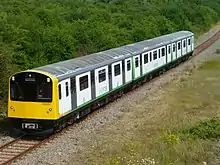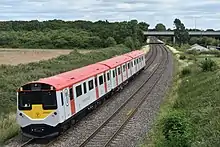Vivarail D-Train
The D-Train is a family of multiple units built by rolling stock manufacturer Vivarail for the British rail network. The units are converted from London Underground D78 Stock, originally manufactured betwewen 1978 and 1981 by Metro-Cammell. The conversion re-uses the D78's aluminium bodyshells with new interiors. It runs on the same bogies but these are rebuilt to as-new standard by Wabtec and fitted with brand new 3-phase AC induction motors sourced from Austria. It is proposed to run 75 units of two or three cars per unit.[1][2] Including prototypes, four variants have been produced or ordered: diesel-electric, battery-powered, diesel/electric hybrid and third-rail DC electric.
| Vivarail D-Train | |
|---|---|
 Class 230 prototype. | |
| Manufacturer | Metro-Cammell (original construction) Vivarail (conversion) |
| Built at | Quinton Rail Technology Centre (conversion) |
| Replaced | Class 150 Class 153 Class 483 |
| Constructed | 2015 - present |
| Operator(s) | |
| Depot(s) | |
| Specifications | |
| Car body construction | Aluminium |
| Car length | Driving Motor: 18.37 m (60 ft 3 in) Other: 18.12 m (59 ft 5 in) |
| Width | 2.85 m (9 ft 4 in) |
| Prime mover(s) | Ford Duratorq |
| Electric system(s) | Hoppecke Li-ion batteries 750 V DC (Third rail) |
| Current collection method | Contact shoe |
| Safety system(s) | AWS, TPWS |
| Coupling system | Wedgelock coupling |
| Track gauge | 1,435 mm (4 ft 8 1⁄2 in) standard gauge |
During August 2016, a prototype was produced for testing and accreditation; the type was planned to be prepared to enter passenger service during the following year.[3] During July 2016, it was announced that the prototype was to be tested in mainline service on the Coventry to Nuneaton Line over a 12-month period with operator London Midland;[4] however, this trial deployment had to be postponed after the prototype was damaged by a fire and could not be repaired quickly enough.[5] During October 2017, West Midlands Trains announced that it would procure three 2-car D-Trains for the Marston Vale line,[6] and the first unit entered service in April 2019.[7] Five 2-car third rail units are being supplied for operations on the Isle of Wight as the British Rail Class 484.
Prototypes

A prototype was produced for testing and accreditation in August 2015.[1] The initial prototype D-Train was built as a three-car diesel-electric unit, which was completed in the summer of 2016, following which it underwent a programme of main-line testing, with the eventual intention that it be used on a year-long trial service on the Coventry to Nuneaton line by London Midland. This however was cancelled when the unit caught fire.[8] This unit was first used in passenger service at the 2017 Rail Live exhibition, running a service from Honeybourne to the event location at Quinton.[9]
The second prototype was built as a two-car battery-electric unit; although self-powered like the original, instead of a diesel engine to power the traction motors, this unit uses batteries that can be recharged from a charging point at each end of its journey. This unit was complete by the summer of 2018, and was put on a testing programme; this culminated in the battery powered unit running a distance of 40 miles using battery power alone, a first for a train in the UK, in January 2020.[10]
A feature that has been reintroduced in these units include the passenger door open buttons. When first introduced in 1980 in unpainted livery the units consisted of door buttons on the exterior and interior pressed by passengers to open the doors. Upon refurbishment, the interior door buttons were removed and the exterior ones were panelled over. After conversion this feature was provided again similar to London Underground pre-refurbishment.
Orders
West Midlands Trains
The first full D-Train order came from West Midlands Trains, which procured a trio of 2-car Class 230 DMUs for use on the Marston Vale line.[6] These are operated under the London Northwestern Railway brand, with the first entering service on 23 April 2019.
Transport for Wales
A second order for Class 230s came from Transport for Wales, with five 3-car sets ordered. Although these are also Class 230s, rather than straight DMUs they will be built as diesel/battery hybrid units, to be used on the Borderlands Line, Conwy Valley line and Chester to Crewe line.[11]
Island Line
In 2019, South Western Railway announced an order for five 2-car D-Train sets for use by its Island Line operation on the Isle of Wight. These were ordered as third rail EMUs, becoming Class 484.[12]
D-Train variants
| Class | Operator | Introduced | Number | Power | Carriages | Carriage Length (m) | Door configuration | End gangways | Image | Notes |
|---|---|---|---|---|---|---|---|---|---|---|
| Class 230 | Vivarail (prototype) | 2015 | 1 | Diesel | 3 | 18.37 m (60 ft 3 in) (DM) 18.12 m (59 ft 5 in) (T) |
Sliding pocket | No |  |
|
| 2018 | 1 | Battery-electric | 2 | |||||||
| West Midlands Trains | 2019 | 3 | Diesel | 2 |  |
|||||
| Transport for Wales | 2020 | 5 | Diesel-Battery | 3 |  |
Not currently In Service | ||||
| Class 484 | Island Line | 2020 | 5 | DC electric | 2 |
References
- "D78 Stock Conversion is Go." Archived 16 July 2015 at the Wayback Machine Modern Railways, December 2014. pp. 37-38.
- "Vivarail Homepage". Vivarail. Retrieved 20 January 2015.
- Wade, Andrew (21 August 2015). "D-Railed: Old tube trains gain a new lease of life". The Engineer. Retrieved 18 April 2016.
- UK, DVV Media. "D-Train to enter service on Coventry - Nuneaton line". Retrieved 23 July 2016.
- Stephen, Paul. "Vivarail D-Train trial cancelled after fire." Rail Magazine, 11 November 2016.
- Gibbs, Nigel (November 2017). "Vivarail 230s for new West Mids franchise as 170s to go". Today's Railways (191): 8.
- "First Class 230 begins passenger services between Bletchley and Bedford".
- "Vivarail test train catches fire over festive period as NUCKLE trial postponed". Rail Technology Magazine. Retrieved 11 August 2018.
- Foster, Stefanie (13 April 2017). "D-Train to carry passengers to Rail Live". Rail Magazine (824). Archived from the original on 6 July 2017. Retrieved 6 July 2017.
- "40 miles on battery power – a UK first for Vivarail". vivarail.co.uk. Vivarail. 15 January 2020. Retrieved 19 February 2020.
- "Vivarail D-Trains for Wales & Borders". Railway Gazette. 7 June 2018. Retrieved 18 September 2019.
- "UK Isle of Wight line's future secured with £26m investment". Railway Gazette. 16 September 2019. Retrieved 18 September 2019.